Click to Skip Ahead
We give NHV Tripsy For Cats a rating of 4.5 out of 5 stars.
NHV Tripsy is a feline urinary and kidney supplement aimed to soothe the lining of a cat’s urinary system, prevent the formation of kidney stones, and reduce inflammation for an all-around more comfortable urinary tract for our kitty friends. Urinary crystals and urinary tract infections may also be prevented with this product.
NHV’s Tripsy supplement comes as a liquid available in a 3.4-oz (100 mL) bottle with a syringe/bulb top for easy measuring. They provide your dosing instructions clearly on the bottle, which you can then give directly to your cat or mix into food.
Urinary inflammation is one of the most common health issues of cats, and NHV’s Tripsy For Cats is one of several supplement choices you can choose from (or mix) to help relieve urinary or kidney disease-related signs in cats.
About NHV Natural Pet Products
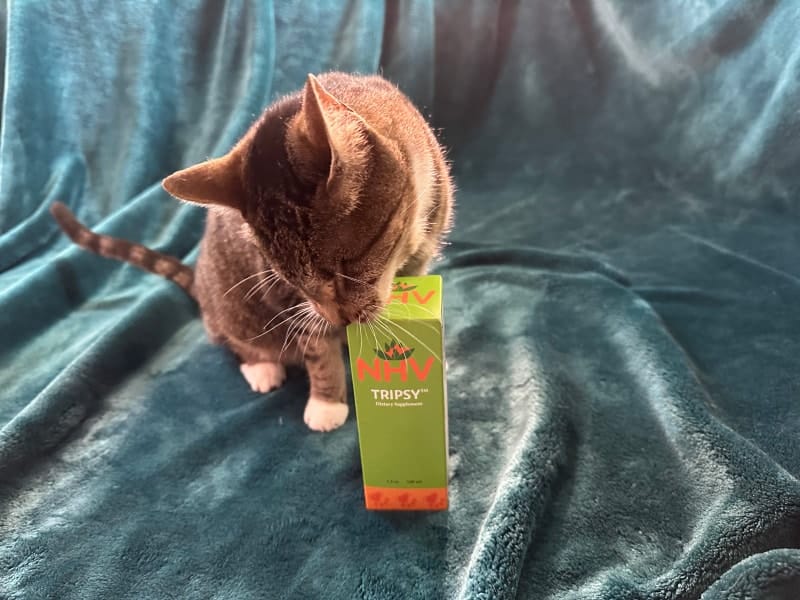
NHV has formulated 100% natural supplements for over 150 different pet health conditions. All of their supplements contain human-grade ingredients and are formulated by herbalist-specialized veterinarians. All of their supplements also undergo multi-step product testing to confirm formulation and safety.
Pet supplements are tricky to trust because there are few if any regulations around their development, what claims of efficacy can be made, or what testing they must undergo. Unlike most other supplement brands, NHV uses research and veterinary expertise to formulate all of its products and goes above and beyond the requirements for testing. They also have products tested in high-quality research studies to support the health claims of their supplements.
When choosing an NHV supplement for your dog or cat and you can feel confident that the product contains what it claims and the ingredients are safe for your pet.
Which Types of Cats Is NHV Tripsy For Cats Best Suited For?
Cats with struvite urinary crystals, kidney stones, recurrent UTIs, or bouts of urinary inflammation best benefit from this product. Many of these cats may already be using prescription urinary or kidney diets to support them, and especially for those without complete control of their symptoms, NHV Tripsy works great in conjunction with other urinary treatments or potentially on its own.
NHV Tripsy Overview
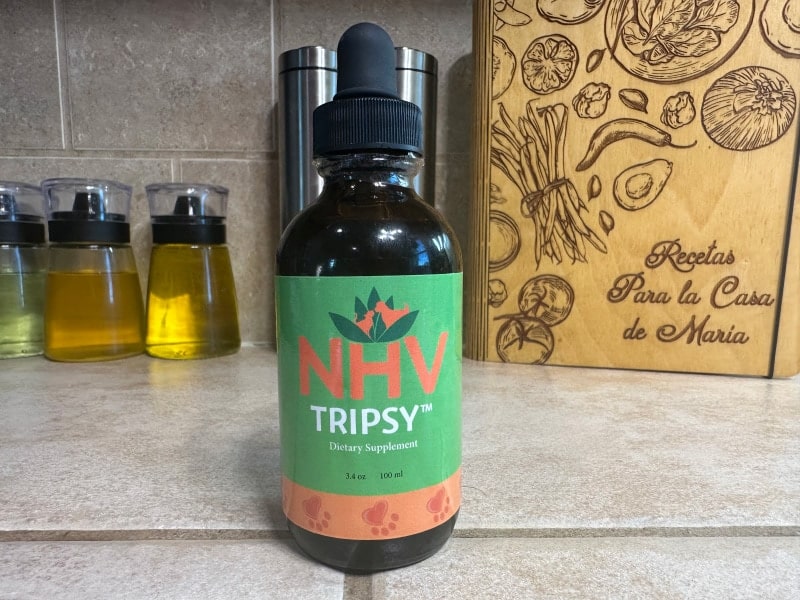
NHV provides a lot of different supplements, even many other urinary and kidney supplements for cats, but here’s what you need to know about their Tripsy supplement for cats specifically.
Specs
- 4-oz (100 mL) oral liquid supplement
- Dosed based on weight from 0.5 mL to 1 mL
- Contains 7 ingredients geared towards optimizing urinary and kidney health
Pricing
NHV Tripsy For Cats is available for $44.95 per bottle on their website. When you buy two bottles, you also receive a discount of $3 and financing options are available through afterpay to help break up the cost over time. You can provide a credit or debit card to pay, or use Paypal or Google Pay.
Contents
NHV Tripsy arrives in a small, green box, which contains the supplement bottle currently capped, and a bulb-top syringe cap separately. You can unseal the cap and replace it with the syringe cap, which has increments up to 1 mL marked up the syringe. When time to administer you simply use pressure on the bulb top to pull up the advised amount of the liquid supplement to give to your cat.
All dosing and ingredient information is available on both the bottle and the box.
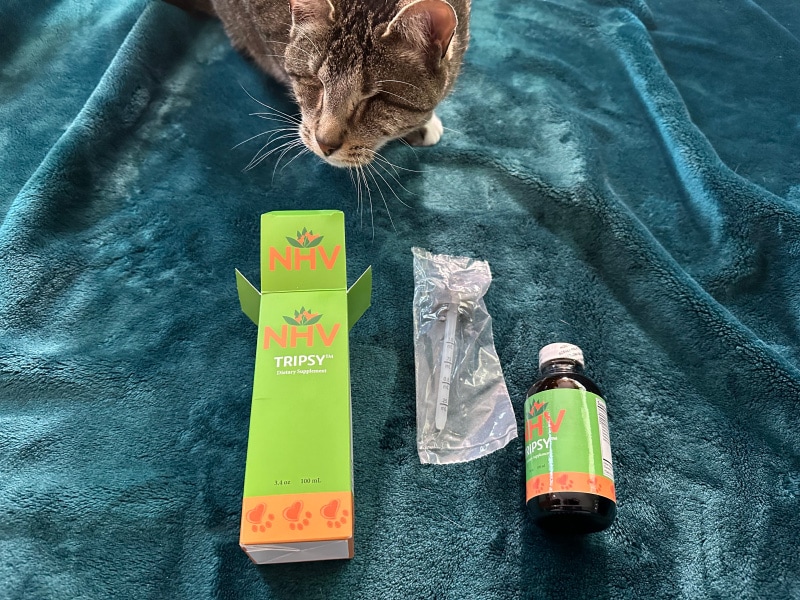
In Summary
- Easy to measure
- Small volumes to administer
- All ingredients have some level of research supporting their use
- Vet approved and formulated
- 100% natural and organic
- Not all cats will like the taste
- Studies on efficacy and dosing in cats specifically is lacking for most ingredients
Key Features
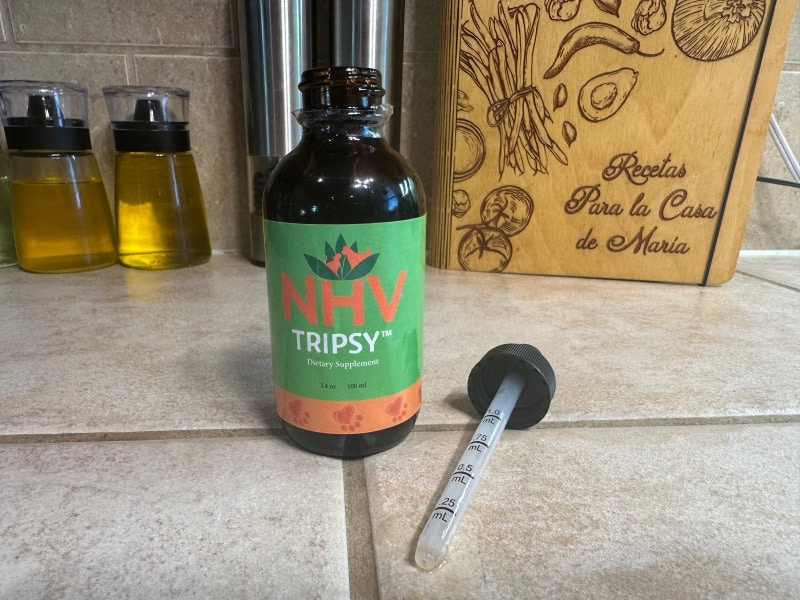
Quality
High-quality pet supplements can be a challenge to find but NHVs products are a great place to start. All of their products go through two-step testing that includes a third-party lab, are 100% natural and organic, and are formulated by veterinarians.
The brown glass bottle for the supplement protects Tripsy For Cats from light, the bulb-top syringe isn’t flimsy or difficult to use, the label is bright, clear, and easy to read, and the product is safe for long-term use in cats.
Palatability
Tripsy For Cats is designed to be palatable to cats so that they’ll drink it directly from a dish or mixed with food, but as we all know, many cats are notoriously picky. My cat is what I consider moderately discerning. Within a couple of days to adjust to the new taste, which is a common issue, he would start eating this placed on top of his food and later he would even just lick it up.
Ingredients
NHV’s Tripsy For Cats contains the following ingredients: stone root, parsley piert, wild hydrangea (root), gravel root, echinacea purpurea, marshmallow, and Oregon grape.
These ingredients are all known to reduce or prevent inflammation, improve urinary and blood flow, aid in the removal or prevention of urinary or kidney crystals or stones, among many other benefits.
Most of these ingredients have some sort of support in high-quality research studies across various species, but unfortunately, research on the effects of these ingredients in cats specifically is lacking. Luckily though, NHV is actively pursuing research for their products, and Tripsy For Cats in particular has at least one study showing early support that it can aid in the dissolution of struvite urinary crystals, which is great.
Is NHV Tripsy a Good Value?
Tripsy For Cats costs $44.95 per bottle, which contains 100 mL. The lowest possible dosing is 0.5 mL given twice daily, which equates to over three months of treatment from a single bottle. For even the heaviest cats, the most you will need to give is 1 mL twice daily, which is still over a month of product per bottle.
For larger cats, approaching $50 every 6 weeks or so may seem pricey for some cat owners, but with pet supplements, you do not want to choose the cheapest available option.
Pet supplement companies are regularly caught with mismatches between the listed ingredients in the supplements and what is actually found in them when tested. Sometimes the active ingredient(s) isn’t found at all and worse, sometimes toxic ingredients are found instead. Other companies may also design a supplement that has irrelevant ingredients that have no support for their claimed use.
While the cost can functionally double based on whether your cat is over or under 16 pounds, NHV puts in the work to provide a product you can trust.
FAQ
Can this help dissolve my cat’s urinary crystals?
The University of Georgia College of Veterinary Medicine compared results from giving six cats Tripsy For Cats at the recommended dosing for two weeks and showed that there was a significant reduction in struvite crystals in these cats’ urine (compared to a placebo). While this is a very small study, the initial results show support for the ability of this supplement to dissolve struvite urinary crystals in cats.
Is wild hydrangea a problem for cats?
The answer to this essentially lies in the differences in toxic properties of plants, depending on which part of the plant we’re discussing. Often, toxic properties are specific to one part of the plant, or some combination of parts. Wild hydrangea’s leaves, flowers, or buds do have a toxic potential, but Tripsy uses the roots, which is not toxic to cats. Additionally, even if another part of the plant was used, research shows a significant amount would have to be ingested by a cat to be dangerous.
Our Experience With NHV Tripsy For Cats
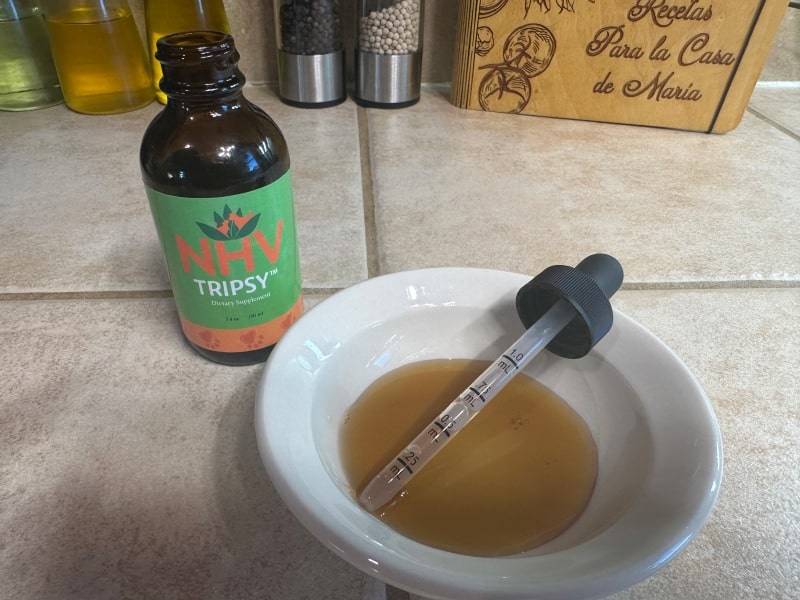
My personal cat, Boots, is a 9-pound domestic shorthair tabby cat who is generally a healthy cat, but he does have Stage 2 Chronic Kidney Disease. I decided to check Boots’s current blood creatinine levels (important kidney value), give him Tripsy For Cats for one month, and then recheck his creatinine afterward to see if anything changed. I also monitored his litter box habits.
While he has no history of urinary crystals, lower urinary tract inflammation, or problems going outside the litter box, Boots struggles with constipation due to his kidney disease, and an irregular urinary schedule.
As I noted above, Boots wasn’t a fan of Tripsy in our initial days. I continued to offer it with food each day, trying it with his dry food or his gravy-like hydration supplement, and after a couple of days of adjustment, he decided he didn’t mind eating it with his food!
As the month progressed, he grew to be excited when he heard me grab the bottle, knowing food or treats would also be coming, and I was able to transition him to simply licking a small bowl clean to take his supplement, and then giving a treat afterward.
At the end of the month, I rechecked Boots’s creatinine levels and found they had not changed, and all was well and stable. I was very happy to find that he became perfectly regular in his urination habits, and I knew exactly what points in the day I could check the litter box and find he had gone. He also suffered no bouts of constipation throughout his month of treatment.
By the end of the month, he was happy to take Tripsy, was excited even, and while it didn’t appear to do much for his kidney values, it did seem to support his urinary health in a measurable way that left him more comfortable and better hydrated.
Based on how Boots handled taking the supplement in the beginning, I would be hesitant to tell an owner of a picky cat that they’ll be easy to give this supplement to, but I do think it would be at least worth trying. I also plan to continue giving Tripsy to my cat and watching his kidney values in the future, as the time it takes to cause changes can vary. He luckily has mild kidney disease, and this might be more impactful for him as it progresses later in his life.
Conclusion
NHV’s Tripsy For Cats urinary and kidney supplement has the potential to provide several important benefits to cats. Considering how common urinary disorders are in cats and based on my own experience with the product, I recommend any cat owner with the time and funds to try this out with their cat. You may not even identify signs of inflammation or discomfort in the urinary tract of your cat until after giving Tripsy to them and seeing an improvement as I did.











